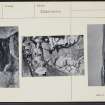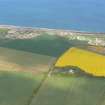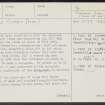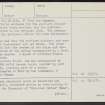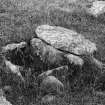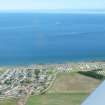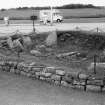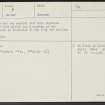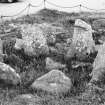Pricing Change
New pricing for orders of material from this site will come into place shortly. Charges for supply of digital images, digitisation on demand, prints and licensing will be altered.
Embo
Chambered Cairn (Neolithic)
Site Name Embo
Classification Chambered Cairn (Neolithic)
Alternative Name(s) Boston House; 'grannies Heilan' Hame'
Canmore ID 15376
Site Number NH89SW 9
NGR NH 8177 9265
Datum OSGB36 - NGR
Permalink http://canmore.org.uk/site/15376
- Council Highland
- Parish Dornoch
- Former Region Highland
- Former District Sutherland
- Former County Sutherland
NH89SW 9 8177 9265
An Orkney-Cromarty type round cairn with two chambers and intrusive short cists and cremations lay 111' NNE of Boston House on the links at about NH 8175 9265. It was a small, irregular, inconspicuous, turf and sand- covered, oval mound, measuring about 42' by 30' which had obviously been much disturbed before 1956 when the first excavation took place (Henshall and Taylor 1959) A rescue dig was undertaken in July 1960 when the landowner proposed to remove the ciarn to make a car-park. It proved to be of such interest that it was preserved in the car-park, although the soft sand-stone of the orthostats is weathering rapidly. The lower part of the cairn was of large flat slabs beneath a mixture of sand and rounded irregular boulders. There was no definite edging to the ciarn, but there was a rough kerb on the SE side, 9' from the chamber. There was no definite evidence for the southern chamber with a smaller cairn being earlier, but the northern might be an addition to the original plan. The passage and entrance to the southern chamber had been deliberately blocked.
One cist had been set into the southern chamber, and contained an intact food-vessel and jet beads. The other had been inserted into the centre of the cairn and contained the skeletons of two babies accompanied by a foodvessel and beaker sherds. A speck of corroded bronze lay near the centre.
Of the nine cremations found, one was accompanied by fragments of a Mid Bronze Age bifid bronze razor, another by part of a bronze blade, probably part of a razor.
The finds were donated to National Museum of Antiquities of Scotland (NMAS) by the landowner, J Macintosh of Embo House.
A S Henshall and H W Y Taylor 1959; A S Henshall and J C Wallace 1965; J M Coles 1966; Information from MS of Chambered Cairns of Scotland, by A S Henshall.
An Orkney-Cromarty chambered cairn as described and planned by Henshall, preserved within an iron railing at NH 8177 9265 in the forecourt of "Grannies Heilan' Hame".
The two chambers and the central cist with capstone survive, but the cist within the S chamber is not evident. The cairn is truncated in the E by the railing and car-park.
Surveyed at 1/2500.
Visited by OS (A A), 23 March 1971.
(Full description).
A S Henshall 1972.
Publication Account (1995)
A low mound excavated in 1956 and 1960 was found to be the remains of a stone cairn containing two neolithic burial chambers and also bronze-age graves. Only the base of the structures is preserved, but the excavated chambers can be viewed with the covering mound removed and give an excellent view of the overall plan and of features not visible in other cairns.
The main chamber is entered from the south, where a short passage with drystone walls leads first into an antechamber and then into the chamber proper, an oval area constructed of six upright slabs with drystone walling between. Most of the original corbelled roof had been destroyed before excavation. At least six ad ults and nine children had been buried in this chamber before it was blocked up. At the other end of the cairn a short passage opens into a second ruined chamber formed of five upright slabs originally linked by drystone walling. Most of this chamber had been disturbed before excavation. Bones of animals and birds, including dog, pig, otter, great auk, duck, guillemot and gannet were found both in the filling of the main chamber and in the body of the cairn.
Part of the original cairn material remains on the west side and beside the passage on the south. The original mound would have been higher, but something the shape of the fenced area. The neolithic cairn was again used as a burial place in the early bronze age, when two stone cists were inserted into the mound. In one, which has been removed, a woman was buried with a food vessel pot and a necklace of black jet beads. The other cist can be seen in the centre of the cairn between the two chambers. It is formed of four stones set on edge and was covered by a flagstone. It contained the bones of two babies, a food vessel pot and a corded beaker. Later in the bronze age cremation burials were inserted into the cairn, one with a bronze razor.
Information from ‘Exploring Scotland’s Heritage: The Highlands’, (1995).



















